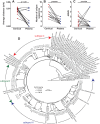Higher sequence diversity in the vaginal tract than in blood at early HIV-1 infection
- PMID: 29346424
- PMCID: PMC5773221
- DOI: 10.1371/journal.ppat.1006754
Higher sequence diversity in the vaginal tract than in blood at early HIV-1 infection
Abstract
In the majority of cases, human immunodeficiency virus type 1 (HIV-1) infection is transmitted through sexual intercourse. A single founder virus in the blood of the newly infected donor emerges from a genetic bottleneck, while in rarer instances multiple viruses are responsible for systemic infection. We sought to characterize the sequence diversity at early infection, between two distinct anatomical sites; the female reproductive tract vs. systemic compartment. We recruited 72 women from Uganda and Zimbabwe within seven months of HIV-1 infection. Using next generation deep sequencing, we analyzed the total genetic diversity within the C2-V3-C3 envelope region of HIV-1 isolated from the female genital tract at early infection and compared this to the diversity of HIV-1 in plasma. We then compared intra-patient viral diversity in matched cervical and blood samples with three or seven months post infection. Genetic analysis of the C2-V3-C3 region of HIV-1 env revealed that early HIV-1 isolates within blood displayed a more homogeneous genotype (mean 1.67 clones, range 1-5 clones) than clones in the female genital tract (mean 5.7 clones, range 3-10 clones) (p<0.0001). The higher env diversity observed within the genital tract compared to plasma was independent of HIV-1 subtype (A, C and D). Our analysis of early mucosal infections in women revealed high HIV-1 diversity in the vaginal tract but few transmitted clones in the blood. These novel in vivo finding suggest a possible mucosal sieve effect, leading to the establishment of a homogenous systemic infection.
Conflict of interest statement
The authors have declared that no competing interests exist.
Figures







References
-
- Keele BF, Giorgi EE, Salazar-Gonzalez JF, Decker JM, Pham KT, Salazar MG, et al. Identification and characterization of transmitted and early founder virus envelopes in primary HIV-1 infection. Proc Natl Acad Sci U S A. 2008;105(21):7552–7. doi: 10.1073/pnas.0802203105 - DOI - PMC - PubMed
-
- Salazar-Gonzalez JF, Bailes E, Pham KT, Salazar MG, Guffey MB, Keele BF, et al. Deciphering human immunodeficiency virus type 1 transmission and early envelope diversification by single-genome amplification and sequencing. J Virol. 2008;82(8):3952–70. doi: 10.1128/JVI.02660-07 - DOI - PMC - PubMed
-
- Boeras DI, Hraber PT, Hurlston M, Evans-Strickfaden T, Bhattacharya T, Giorgi EE, et al. Role of donor genital tract HIV-1 diversity in the transmission bottleneck. Proc Natl Acad Sci U S A. 2011;108(46):E1156–63. doi: 10.1073/pnas.1103764108 - DOI - PMC - PubMed
-
- Haase AT. Targeting early infection to prevent HIV-1 mucosal transmission. Nature. 2010;464(7286):217–23. doi: 10.1038/nature08757 - DOI - PubMed
-
- Hladik F, McElrath MJ. Setting the stage: host invasion by HIV. Nat Rev Immunol. 2008;8(6):447–57. doi: 10.1038/nri2302 - DOI - PMC - PubMed
Publication types
MeSH terms
Substances
Grants and funding
LinkOut - more resources
Full Text Sources
Other Literature Sources
Medical
Molecular Biology Databases
Miscellaneous

